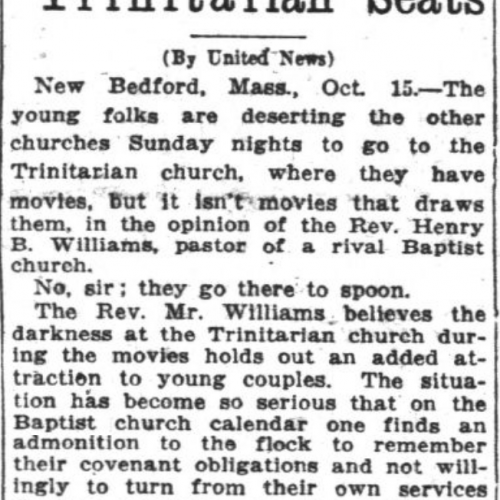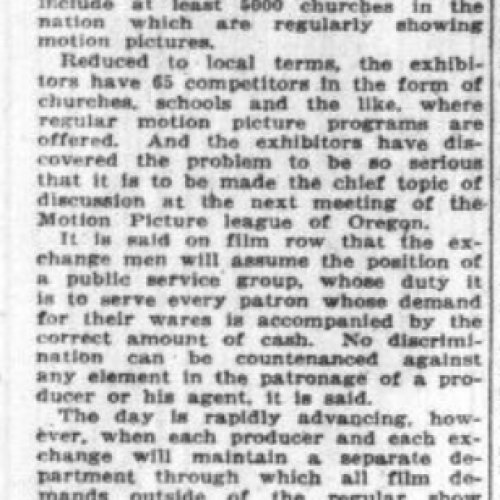In The Oregon Daily Journal an article titled “Producers Not Weeping About Church Movies,” it is mentioned that “churches and schools of the land” are invading the business field of motion picture exhibitors and theater managers. However, it is made clear that anything the exhibitors and managers do in order to try to stop the invasion of these other businesses must be done without “assistance [from] the film producers and exchange men.” I am assuming that film producers are ecstatic about their films being displayed in any place which is why they may not intrude when it comes to making sure only movie theater owners get to display the films they create.
The article states that there are “...at least 5000 churches in the nation which are regularly showing motion pictures” outside of movie theatres as they have taken the time to install projection machines. These churches may have decided to do so in order to gain more attendance due to having the popular entertainment displayed in their businesses. In the Portland area, there seems to have been around “65 competitors in the form of churches, schools, and the like…” which most likely frustrated movie theater owners if they were losing business because of this. The competition was so serious, it was said to be “...the chief topic of discussion at the next meeting of the Motion Picture league of Oregon.” One of the proposed solutions that was mentioned was to give the exhibitors “preference in booking dates” while keeping the churches and schools in mind. The businesses wanted to prevent as little direct competition as possible.
In the Oregon Daily Journal article titled “Spooning Chance at Church Movies Fills Trinitarian Seats,” it is revealed that movie theatres are not the only place people could go to watch movies in Portland. Churches would feature motion pictures to the extent of having newspapers discuss it themselves. It was described that churches were a popular location in regards to movie-going because it possibly gives a chance for young couples to spoon while the lights are out. It is clear that locations other than movie theaters were successful as it allowed for more opportunities for people to be social and experience movie-going in a different setting.
Based on Cara Cadoo’s article “‘Put Together to Please a Colored Audience’: Black Churches, Motion Pictures, and Migration at the Turn of the Twentieth Century,” “hundreds of black men and women screen motion pictures in black lodges, schools, and, most frequently, churches” (780). This was very important for African Americans as the films that were shown were “...suited to the needs and public spaces of modern black life” (Caddoo 780). In general, it was important for movie-going to exist outside of movie theaters in order to provide a chance for more diverse experiences and audiences that were able to watch films and enjoy entertainment comfortably.
Works Cited
Caddoo, Cara. "“Put Together to Please a Colored Audience”: Black Churches, Motion Pictures, and Migration at the Turn of the Twentieth Century." The Journal of American History 101.3 (2014): 778-803.
Oregon Daily Journal, April 17, 1921, p. 47
Oregonian Daily Journal, October 16, 1921, p. 15

